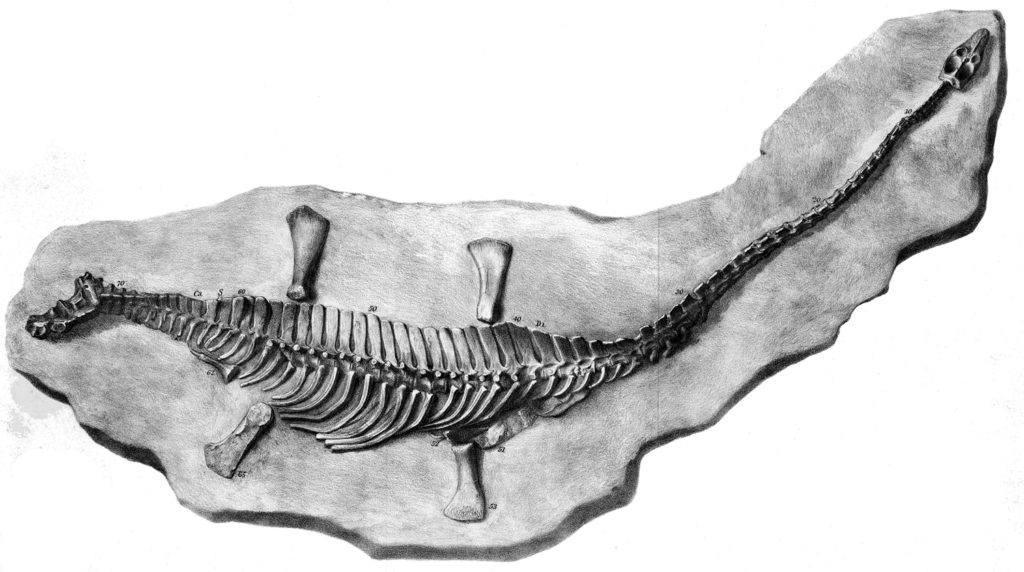Microcleidus

M.homalospondylus
Microcleidus is a medium (4.27 m) to large (5.03 m) plesiosauroid with a small head and a long neck containing 38–39 cervical vertebrae.
Watson (1909) erected Microcleidus to accommodate fossil material belonging to ‘P.’ homalospondylus and ‘P.’ macropterus (Watson 1911). Both species were considered valid by Seeley (1865), Blake (1876) and Watson (1911) on the basis of slight differences in the limbs, but a modern systematic review of the postcranium of Microcleidus is required to assess this variation.
Microcleidus has a sculptured premaxilla, five premaxillary teeth, elongate and delicate teeth, a reduced first premaxillary tooth, the frontal contacts the pineal foramen, the frontal is excluded from the temporal fenestra, the maxilla and squamosal do not contact, a jugal excluded from the orbit and temporal fenestra margins, a postorbital-squamosal contact, no anterior interpterygoid vacuity, the pterygoids contact each other posterior to the posterior interpterygoid vacuities, a ventromedial flange is present on the posterior ramus of the pterygoid, a keeled parasphenoid, no ectopterygoid boss, and a sculptured dentary with a ventral midline keel. The lateral surface of the cervical centrum bears a longitudinal ridge and the ventral surface of the centrum is flat. The dorsal neural spines are tall (twice the height of the centrum). The femur is longer than the humerus.
There are at least four species of Microcleidus: M. homalospondylus, M. macropterus, M. tournemirensis (=Occitanosaurus), and M. melusinae. Some authors also regard Hydrorion brachypterygius as a species of Microcleidus (Benson et al. 2012).
Microcleidus homalospondylus is a medium (NHMUK PV OR 36184 is 4.27 m) to large (YORYM G502 is 5.03 m) plesiosauroid with a small head (NHMUK PV OR 36184 is ~230 mm ) and a long neck containing 38 cervical vertebrae (according to Brown et al.2013). It differs from M. macropterus because the humerus has a straight preaxial (anterior) margin and the femur has a concave preaxial margin (Watson 1911).
Microcleidus homalospondylus is known from three sub-complete specimens from the Yorkshire coast (the lectotype NHMUK PV OR 36184 and paralectotype YORYM G502, and referred specimen MANCH L7077). NHMUK PV OR 36184 was originally described by Owen (1865) as Plesiosaurus homalospondylus and the skull was later acid-prepared and described in detail by Brown et al. (2013). This species is also known from the bifrons Biozone of Wellingborough, Northamptonshire, UK (MANCH L7135; Watson 1909). The species is known from the Alum Shale Member, bifrons Biozone, Whitby–Saltwick cliff section (Owen 1865; Brown et al. 2013; Benton and Taylor 1984).
Microcleidus macropterus is a large (4.62 m) plesiosauroid with a small head (229 mm) and a long neck (1.78 m) containing approximately 39 cervical vertebrae. It differs from M. homalospondylus because the humerus has a concave preaxial (anterior) margin, and the femur has a straight preaxial margin (Watson 1911).
Seeley (1865) erected this species (as Plesiosaurus macropterus) based on a single specimen (CAMSM J35182, previously labelled as ‘P. grandipennis’) discovered at Saltwick in 1841 (Benton and Taylor 1984). The specimen, which is currently on display in the Sedgwick Museum of Geology, Cambridge, was described by Watson (1911) and a historical account of it is given by Benton and Taylor (1984) and Osborne (1999). Watson (1911) suggested that some M. homalospondylus material (e.g. YORYM G502) might really belong to M. macropterus. Contra Benton and Spencer (1995), CAMSM J35182 was not described by Watson (1911) as the neotype of Eretmosaurus. Blake (1876, p. 246) briefly described and figured parts of a skeleton named Plesiosaurus dubius and considered it “allied to, if not identical with [Microcleidus macropterus]”. This material has since been lost (Benton and Taylor 1984), but was mentioned by Benton and Spencer (1995) under the name ‘Eretmosaurus macropterus’.
There is conflicting information on the provenance of the type specimen of M. macropterus (CAMSM J35182) but it is from the Alum Shale Member, Whitby Mudstone Formation, bifrons Biozone, Saltwick, near Whitby (Benton and Taylor 1984).
Microcleidus tournemirensis was previously referred to the now invalid genus Occitanosaurus. See that genus page for more information about that species.
Microcleidus melusinae from the Toarcian of Luxembourg was named by Vincent et al. (2019). The holotype specimen (MNHNL TV434) is a well-preserved skull, neck, and anterior part of the body.




